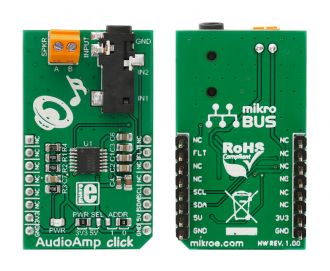
We strongly encourage users to use Package manager for sharing their code on Libstock website, because it boosts your efficiency and leaves the end user with no room for error. [more info]

Rating:
Author: MIKROE
Last Updated: 2019-01-29
Package Version: 1.0.0.1
mikroSDK Library: 1.0.0.0
Category: Amplifier
Downloaded: 5514 times
Not followed.
License: MIT license
AudioAmp click is a mikroBUS add-on board that functions as a mono audio amplifier. It is driven by a Texas Instruments LM48100Q-Q1 Boomer Mono, 1.3W Audio Power Amplifier IC.
Do you want to subscribe in order to receive notifications regarding "AudioAmp click" changes.
Do you want to unsubscribe in order to stop receiving notifications regarding "AudioAmp click" changes.
Do you want to report abuse regarding "AudioAmp click".

Library Description
The library covers all the necessary functions to control AudioAmp Click board. Library have drivers for set volume lvl ( CH1, CH2 or MUX ), enable and disable amplifier function, set mute and unmute mode function, etc.
Key functions:
void audioamp_setInput( uint8_t inputMode ) - Set input mixer mode function.void audioamp_enable() - Enable function.void audioamp_setVolume( uint8_t volumeValue ) - Set volume function.Examples description
The application is composed of the three sections :
void applicationTask()
{
mikrobus_logWrite( " Set volume to lvl 15 ", _LOG_LINE );
mikrobus_logWrite( " for the next 10 sec. ", _LOG_LINE );
audioamp_setVolume( 15 );
Delay_ms( 10000 );
mikrobus_logWrite( "----------------------", _LOG_LINE );
mikrobus_logWrite( " Set volume to lvl 5 ", _LOG_LINE );
mikrobus_logWrite( " for the next 15 sec. ", _LOG_LINE );
audioamp_setVolume( 5 );
Delay_ms( 15000 );
mikrobus_logWrite( "----------------------", _LOG_LINE );
mikrobus_logWrite( " Set volume to lvl 10 ", _LOG_LINE );
mikrobus_logWrite( " for the next 20 sec. ", _LOG_LINE );
audioamp_setVolume( 10 );
Delay_ms( 20000 );
mikrobus_logWrite( "----------------------", _LOG_LINE );
mikrobus_logWrite( " Mute mode ", _LOG_LINE );
mikrobus_logWrite( " for the next 5 sec. ", _LOG_LINE );
audioamp_muteMode();
Delay_ms( 5000 );
mikrobus_logWrite( "----------------------", _LOG_LINE );
mikrobus_logWrite( " Unmute mode ", _LOG_LINE );
audioamp_unmuteMode();
Delay_ms( 100 );
mikrobus_logWrite( "----------------------", _LOG_LINE );
}
Other mikroE Libraries used in the example:
Additional notes and information
Depending on the development board you are using, you may need USB UART click, USB UART 2 click or RS232 click to connect to your PC, for development systems with no UART to USB interface available on the board. The terminal available in all MikroElektronika compilers, or any other terminal application of your choice, can be used to read the message.